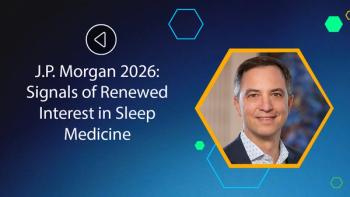
- Pharmaceutical Executive-06-01-2006
- Volume 0
- Issue 0
Who's Coming to Meetings?
Meeting Spend: Take stock of how much your company can and does spend on promotional meetings. And look carefully at the effects of new compliance regulations on audience recruiting. Among survey respondents, about half work for companies that spent less than $1 million a year on promotional meetings. The other half spent more, sometimes in excess of $5 million a year. About half of the respondents forecast a 15-percent rise in meeting budgets next year. The other half did not expect changes in the budget.
Pharma companies compete to seat the "right" audience of physicians at professional meetings and conferences. And some companies lose out, since the number of meetings continues to grow faster than the supply of doctors. A recent survey of Pharmaceutical Executive readers by Maritz Travel suggests that one in six companies rates itself as "below average" or "poor" when it comes to getting a good physician turnout at meetings, and more than one in seven say their company has trouble reaching the right physician audience—usually a list of doctors drawn from prescribing data.
What can planners do to improve? Pharma companies need to study the audience they want to attract. First, they have to get to know their audience. Who's coming to meetings now? Then they should define their ideal audience and figure out how they can offer the greatest value to physicians who make up that audience. Everyone wants the doctor's time, and all pharma companies strive to get in front of the key physicians. Learn what motivates your audience to attend and, more important, to participate.
Almost every respondent indicated that the in-person meeting is their company's favored format. One-on-one sales calls came in a close second among preferred ways to pitch ideas to physicians. Like CD-ROMs, which were also popular vehicles, personal meetings were deemed efficient ways to achieve strong physician participation, respondents said. Teleconferences also proved popular, but webinars were used less often. The least efficient way to reach doctors, respondents said, was the recorded telephone message.
Compliance
Of course, companies must follow a new set of rules when they try to get doctors to come to meetings. This was a hot topic at many companies over the past year. Respondents to our non-scientific survey report that they made changes as a result of new regulations. They improved training and procedures, and completely reevaluated promotional programs to institute procedures that prioritize meeting compliance regulations over maximizing sales opportunities. Some have introduced systems to list detailed reports of spending by physician names and sometimes by medical license numbers. They also implemented systems to identify remuneration by customer to ensure that appropriate staff is aware of compliance regulations.
When it comes to attracting doctors to meetings and conferences, the average pharma company is, well, average. Half of all respondents said their companies were squarely in the middle of the pack when it comes to filling conference halls. But more respondents saw their company attracting the right mix of doctors. In fact, more than four in 10 of those completing the online survey reported above average or excellent targeting of preferred attendees. Nearly one in five respondents said their companies failed to achieve good physician turnout for conferences. Only one in seven fell short in attracting the preferred MDs.
Many survey respondents mentioned that changes in the compliance regulations resulted in a more "balanced playing field" and eliminated unfair competition. The best products rise to the top and get prescribed, regardless of a company's ability to spend dollars to entertain/inform physicians. The new regulatory environment keeps the focus on the product and the disease, not on the venue. It puts the emphasis of lunch programs on the clinical and scientific content, not the entertainment value.
Promotional budgets vary widely-from $10,000 to $50 million per year among this group of respondents. Fully a third of those surveyed said their company spent less than $500,000 per year on promotional meetings. But regardless of the amount of money in the promotional budget, respondents seemed to have a strong preference for smaller, in-person meetings. Two thirds preferred in-person gatherings, and nearly as many opted for in-person meetings. Nine of ten respondents said the money was well-accounted-for by mandatory compliance procedures: Their companies tracked the incentives and honoraria paid to attendees.
In addition, many respondents hoped compliance regulations could improve outsiders' perceptions of the industry by removing the "kickback stigma" associated with luxury entertainment. By improving the perception of the industry, pharma would develop more appropriate customer interactions. Regulations are good for the industry, if all companies follow them. But some respondents complained that new regulations have decreased the educational value of some programs. Physicians are looking for cutting-edge information and clinical updates. But the new regulations create too many new hoops to jump through. The end result: Information is out of date by the time it is approved for use. The regulations also force companies to dedicate additional manpower to compliance and to rein in sales people, who become timid when interacting with targets. For this reason, some product information does not get conveyed for fear of breaking promotional guidelines. It is harder for representatives to build rapport or even get access to key physicians.
Belief Statements
Most companies appear to be taking compliance seriously. Two out of three say that pharma strictly follows the new guidelines. Many report that dedicated compliance departments, officers, or legal staff handle compliance requests at their company. Companies report an average of 24 compliance requests in the past year. Six of 10 were from states; the others were issued by federal agencies. A few companies received most of these requests. Half of the respondents said their companies received fewer than nine compliance requests; just over a quarter received 10 to 20 requests; the remaining companies received more than 20 apiece.
Respondent Profile
Attracting a Better Audience
Compare your ideal audience with your "typical" audience—are they the same? Conduct research among members of your ideal audience; learn what they want/expect from professional meetings; find out what meeting forums/topics they prefer; ask questions, such as preferences for format/frequency/timing of meetings, etc. Don't rely on guesswork, untested assumptions, or the individual opinions of your sales reps or other team members. Do the research.
Research methods may include:
»Developing and distributing short studies/questionnaires at meetings and sales calls.
» Conducting focus groups or one-on-one interviews with select members of the target audience.
» Commissioning telephone/e-mail studies among a statistically representative audience sample.
» Sharing results with meeting planners and others.
The meeting format needs to match your audience goals. Nine of 10 companies relied on in-person meetings, while 85 percent said they also use one-on-one, in-person sales calls. (These formats were considered most effective for conveying product information and gaining physician participation.) Recorded information broadcast by telephone (28 percent) and as webinars (46 percent) were the formats used least often.
Methodology
The Maritz Pulse-Check Study was sent to a select group of 3,337 Pharmaceutical Executive subscribers most likely to be involved with management and compliance issues related to promotional meeting budgets. A total of 61 respondents completed the online survey. Study respondents claim to have worked in the pharmaceutical industry for an average of 18 years. The newest employee reported three years of service. The oldest claimed 35 years in pharma. Nearly one half of the study respondents work at the top 10 pharmaceutical companies, by 2004 revenues.
The data obtained in this study were not a random selection of eligible subscribers and therefore should be viewed as directional only. The results of the study are not representational or projectable to all Pharmaceutical Executive subscribers nor to the pharmaceutical industry as a whole. Drawing conclusions about the pharmaceutical industry or Pharm Exec subscribers are not appropriate.
Cindy D'Aoust is senior vice president at Maritz Travel Company. She can be reached at
Articles in this issue
over 19 years ago
What You Need to Know About Adaptive Trialsover 19 years ago
What Type of Brand Are You?over 19 years ago
Setting the Standardover 19 years ago
Washington Report: Promises to Keepover 19 years ago
King Without the Crownover 19 years ago
Personalized Medicine Meets the Real Worldover 19 years ago
Leadership: On the Firing Lineover 19 years ago
Thought Leader: Paul Chang, IBMover 19 years ago
Global Report: People Problemsover 19 years ago
From the Editor: Forecast — and FastNewsletter
Lead with insight with the Pharmaceutical Executive newsletter, featuring strategic analysis, leadership trends, and market intelligence for biopharma decision-makers.




